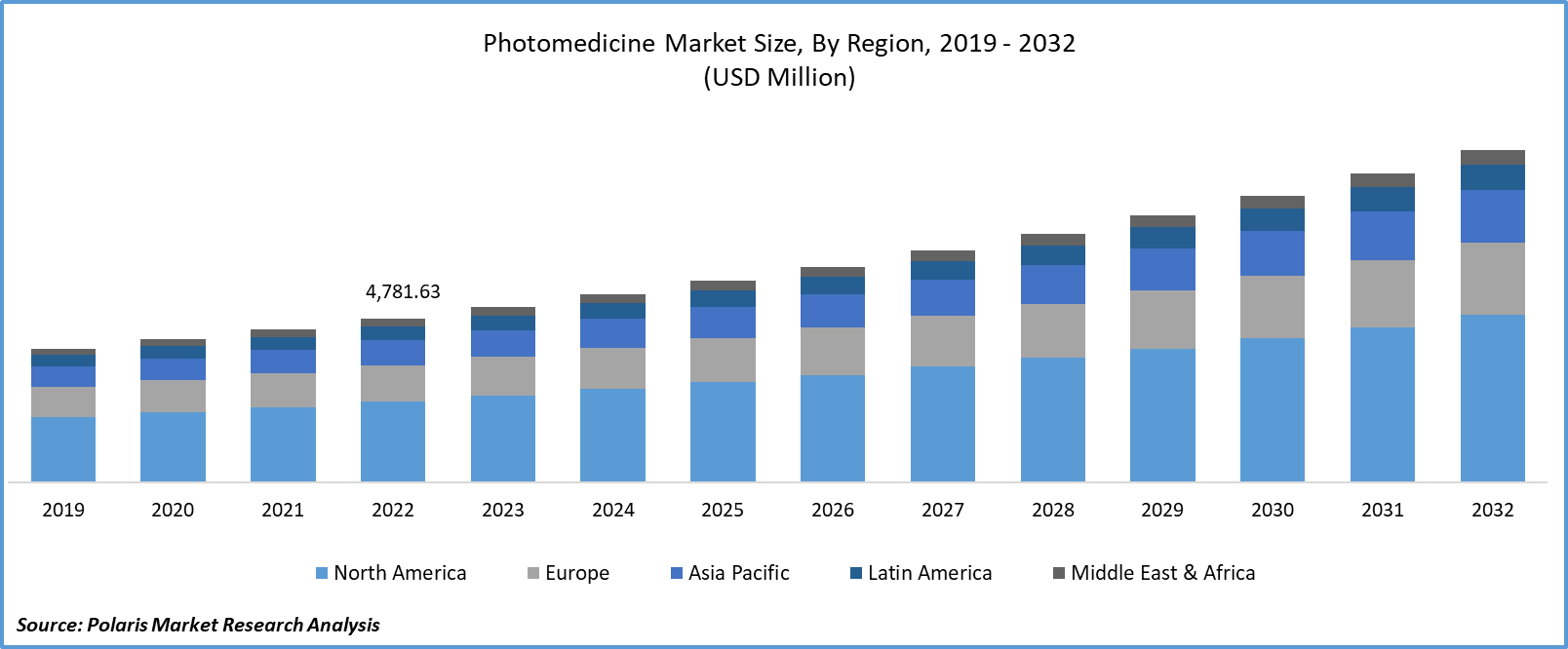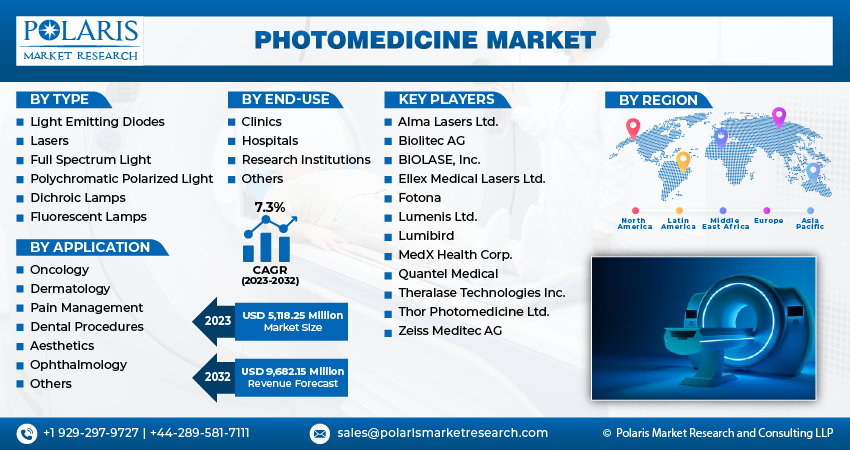
Photomedicine Market Share, Size, Trends, Industry Analysis Report
By Type (Light Emitting Diodes, Lasers, Full Spectrum Light, Polychromatic Polarized Light, Dichroic Lamps, Fluorescent Lamps); By Application; By End-Use; By Region; Segment Forecast, 2023- 2032
- Published Date:Dec-2023
- Pages: 119
- Format: PDF
- Report ID: PM4125
- Base Year: 2022
- Historical Data: 2019-2021
Report Outlook
The global photomedicine market was valued at USD 4,781.63 million in 2022 and is expected to grow at a CAGR of 7.3% during the forecast period.
Photomedicine, positioned at the dynamic juncture of medicine and light-based technologies, has recently experienced rapid progress. By harnessing the unique properties of light for purposes spanning diagnosis, therapy, and research, photomedicine has seen remarkable growth and innovation. This rapidly growing field has attracted considerable interest from researchers, healthcare professionals, and industry pioneers alike. Positioned at the convergence of state-of-the-art technology and healthcare, the market represents a promising frontier for advancing medical diagnostics and therapies. This dynamic discipline leverages the potential of light across a spectrum of applications, encompassing diagnostics and therapeutic interventions.

To Understand More About this Research: Request a Free Sample Report
The integration of photomedicine into telemedicine platforms allows for remote consultations and treatments. It not only expands the reach of photomedicine services but also enhances convenience for patients, especially those in underserved or remote areas. Moreover, continued advancements in nanotechnology are poised to revolutionize drug delivery systems in photomedicine. Targeted therapies utilizing nanoparticles have the potential to enhance the efficacy of treatments while minimizing off-target effects.
For instance, in October 2022, Biolase introduced a research grant platform designed to expedite the process of submitting, assessing, and approving research initiatives. This initiative aims to bolster the already robust body of clinical evidence underpinning Biolase's laser technology. Biolase specifically invites studies in areas such as pediatric dentistry, endodontics, periodontics, implantology, and photobiomodulation (PBM), with the objective of advancing minimally invasive laser technology within these specialized fields.
However, substantial initial investment expenses, stringent regulatory compliance challenges, and limited reimbursement policies are some of the factors hampering the growth of the market. Embracing cutting-edge photomedicine technologies often demands a substantial upfront financial commitment. For smaller healthcare establishments and clinics, this financial hurdle can act as a deterrent, potentially restricting their ability to provide state-of-the-art photomedicine services.
The stringent regulations overseeing medical devices and treatments present a formidable challenge for industry players. Ensuring adherence to rigorous safety and efficacy standards can entail a resource-intensive and time-consuming process, potentially impeding the swift introduction of new photomedicine products.

For Specific Research Requirements: Request for Customized Report
Additionally, in certain regions, policies governing reimbursement for photomedicine procedures may be restrictive or even absent. It can directly impact the accessibility of these treatments for patients, particularly those who lack private insurance coverage.
Growth Drivers
Technological Advancements
The rapid progress in light-based technology advancements has been a cornerstone of the photomedicine market's growth. Innovations in laser technology, imaging techniques, and phototherapy modalities have expanded the scope and efficacy of photomedicine applications. These advancements have facilitated more precise diagnoses and targeted therapeutic interventions.
Moreover, in an era where patients increasingly seek minimally invasive treatment options, photomedicine has emerged as a viable and preferred choice. Procedures like photodynamic therapy (PDT) and low-level laser therapy (LLLT) offer effective treatments with reduced recovery times and minimal side effects compared to traditional surgical interventions.
Report Segmentation
The market is primarily segmented based on type, application end-use, and region.
|
By Type |
By Application |
By End-Use |
By Region |
|
|
|
|
To Understand the Scope of this Report: Speak to Analyst
By Type Analysis
Laser Segment Held the Largest Market Share in 2022
The laser segment held the largest market share in 2022. Laser-based therapies have emerged as indispensable tools across diverse medical specialties like dermatology, ophthalmology, and dentistry. The introduction of advanced laser systems has significantly enhanced treatment precision, minimizing collateral damage to surrounding tissues. Furthermore, the surging popularity of lasers in cosmetic and aesthetic procedures has spurred demand even further. Ongoing research and development efforts suggest an even greater influence of lasers in shaping the future of photomedicine. The adaptability and widening scope of laser applications in medicine are projected to sustain substantial growth in this segment, heralding a transformative era in modern healthcare.
By Application Analysis
The Ophthalmology Segment is Expected to Witness the Fastest Growth During the Forecast Period
The ophthalmology segment is expected to witness the fastest growth during the forecast period, primarily propelled by technological innovations. Innovations such as Optical Coherence Tomography (OCT) and laser-assisted cataract surgery have brought about a transformation in eye care. OCT offers high-resolution imaging, facilitating precise diagnoses of conditions like macular degeneration. Laser technology has transformed cataract surgery, improving precision and recovery. Photocoagulation using lasers is now standard in treating retinopathy and macular edema. With an aging global population and increasing eye-related conditions, demand for innovative ophthalmic treatments is on the rise. Integration of artificial intelligence in ophthalmic imaging further enhances diagnostic capabilities. Continued research and technological progress promise sustained expansion in this segment, contributing significantly to the market.
By End-Use Analysis
The Hospital’s Segment Held a Significant Revenue Share in 2022
In 2022, the hospital segment held a significant revenue share, underpinned by a surge in demand for advanced medical technologies. Hospitals increasingly incorporate photomedicine solutions for diagnostics and therapeutic interventions. Technologies like laser-assisted surgeries, photodynamic therapy, and light-based imaging techniques are becoming integral in various medical specialties. The shift towards minimally invasive procedures and the need for precise diagnostics are driving this trend. Moreover, the expanding applications of photomedicine in oncology, dermatology, and ophthalmology further bolster its adoption in hospital settings. With a continuous emphasis on cutting-edge medical practices, the hospital segment is poised for sustained growth in the market.
Regional Insights
North America Held the Largest Market in 2022
The North America held the largest market share in 2022 due to factors such as advanced healthcare infrastructure, extensive research and development initiatives, and a high adoption rate of cutting-edge medical technologies. The region is experiencing a surge in chronic diseases, compelling a demand for innovative photomedicine solutions. Additionally, the aging demographic and an increasing preference for minimally invasive treatments are contributing to market expansion.
Within North America, the U.S. leads the market with a well-established healthcare system and a thriving medical technology sector. Canada closely follows suit, benefiting from its strong healthcare infrastructure and high healthcare expenditure.
Mexico, while showing steady progress, is emerging as a key player in the market in North America. The country's evolving healthcare landscape and growing healthcare investments are propelling the adoption of photomedicine technologies. With a shared commitment to advancing medical care, North American countries collectively drive the growth of the photomedicine market in the region.
The Asia-Pacific anticipated the fastest market during the forecast period, fueled by factors such as increasing healthcare expenditure, a burgeoning population, and a rising prevalence of chronic diseases. In countries like China and India, expanding middle-class populations are driving healthcare demand, resulting in the swift adoption of photomedicine technologies. Moreover, these nations are investing in advanced medical facilities and research, propelling the market's expansion. Japan, with its advanced healthcare infrastructure, leads the market, benefiting from a strong emphasis on medical innovation and research. As the Asia-Pacific region embraces the benefits of photomedicine, it is poised for continued growth, offering vast opportunities for market players and advancements in medical care.
Key Market Players & Competitive Insights
The market is anticipated to witness competition due to the existence of several players. Major service providers in the market are continuously upgrading their technologies to stay ahead of the competition and to ensure integrity, efficiency, and safety. These players focus on partnership, product upgrades, and collaboration to gain a competitive advantage over their peers and capture a significant market share.
Some of the major players operating in the global market include:
- Alma Lasers Ltd.
- Biolitec AG
- BIOLASE, Inc.
- Ellex Medical Lasers Ltd.
- Fotona
- Lumenis Ltd.
- Lumibird
- MedX Health Corp.
- Quantel Medical
- Theralase Technologies Inc.
- Thor Photomedicine Ltd.
- Zeiss Meditec AG
Recent Developments
- In October 2022, Lumenis bolstered its aesthetic offerings by acquiring LightMed, thus broadening its portfolio with LightMed's innovative solutions for collagen remodeling and skin rejuvenation.
- In March 2022, Lumenis unveiled its latest laser innovation, NuEra Tight, designed for advanced skin treatments. This cutting-edge solution combines radiofrequency and laser technologies synergistically, ensuring the attainment of optimal results in skin rejuvenation.
Photomedicine Market Report Scope
|
Report Attributes |
Details |
|
Market size value in 2023 |
USD 5,118.25 million |
|
Revenue forecast in 2032 |
USD 9,682.15 million |
|
CAGR |
7.3% from 2023 – 2032 |
|
Base year |
2022 |
|
Historical data |
2019 – 2021 |
|
Forecast period |
2023 – 2032 |
|
Quantitative units |
Revenue in USD million and CAGR from 2023 to 2032 |
|
Segments covered |
By Type, By Application, By End-Use, By Region |
|
Regional scope |
North America, Europe, Asia Pacific, Latin America, Middle East & Africa |
|
Customization |
Report customization as per your requirements with respect to countries, region, and segmentation. |
